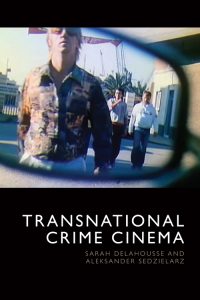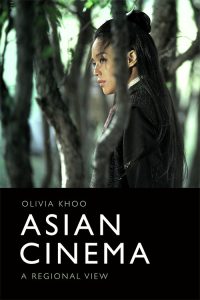Use the code EVENT30 to save 30% on books
Year: 2022
Editors: Sarah Delahousse and Aleksander Sedzielarz
- Contributes a genealogical approach to debates on critical transnationalism
- Demonstrates that representations of crime in cinema are part of an ongoing recognition and reordering of relations of power at the levels of individual, collective, and state
- Offers new angles on the work of a diverse set of directors and films connected through an attraction to crime narrative
- Tracks the changing scope and influence of transnational crime through studies of changing patterns of production moving through film, video and digital streaming that reveal cinema’s place within larger transnational structural and economic change
- Contains original research on social, political, and economic aspects of popular film that connects to topics in cultural studies, area studies (especially Latin America, the Balkans, South and East Asia, and the Middle East), and new media studies
- Offers a theory of filmic transnationalism in which cinema has coevolved with a neoliberal order of government actors and criminal organizations, as well as oligarchic and corporate regimes
Contents:
List of Figures
Acknowledgements
Introduction (Aleksander Sedzielarz and Sarah Delahousse)
Section 1: Transcription
1. Illuminating the Black Film: The Weimar Origins of the Argentine Policial, the Curious Case of ‘El Metteur’ James Bauer and Crime as Transnational Signifier (Aleksander Sedzielarz)
2. Retracing Mafia Locality (David Rodríguez Martínez)
3. Funhouse Noir: Escapist Expressionism in Samuel Khachikian’s Delirium (Ramin Sadegh Khanjani)
Section II: Transgression
Part I: On the Boundaries of Nation and Ideology: Criminal Heroes at the Discursive Limits of Genre, Gender and the Body
4. Crime Without Borders: Marginality and Transnational Power in Jacques Audiard’s Un prophète (Julianna Blair Watson)
5. Three Crime Films by Jia Zhangke: A Transnational Genealogy of Social and Personal Turmoil (Eren Odabasi)
6. Tit for Tat: Avenging Women and Self-Fashioning Femininity in Malayalam Cinema (Rohini Sreekumar and Sony Jalarajan Raj)
Part II: Modes of Transgression vis-à-vis State Repression and Violence
7. Communist Noir: The Hunt for Hidden Traitors, Saboteurs, Spies, Revisionists, and Deviationists in Albania’s Revolutionary Vigilance Films of the 1970s and 1980s (Jonida Gashi)
8. The Short Arm of the Law: The Post-Dictatorship Crime Film as a Barometer for Justice in Contemporary Argentina (Jennifer Alpert)
9. The Case of the Spanish Gialli: Crime Fiction and the Openness of Spain in the 1970s (Fernando Gabriel and Pagnoni Berns)
Section III: Transvaluation
10. Franchising the Female Hero: Translating the New Woman in Victorin Jasset’s Protéa (1913), France’s First Female Spy Film (Sarah Delahousse)
11. Shirkers (2018) Lost and Found?: Tracing Transsensorial Trauma in a True-Crime Road Movie (Jiaying Sim)
12. Gated Crimes: Neoliberal Spaces and the Pleasures of Paranoia in Las viudas de los jueves (2009) and Betibú (2014) (Jonathan Risner)
13. Ensemble of Experts: Relentless as ‘Nigerian Noir’ (Connor Ryan)
Postscript: Desires for Transit and Mobile Genealogies of Popular Cinema (Aleksander Sedzielarz and Sarah Delahousse)
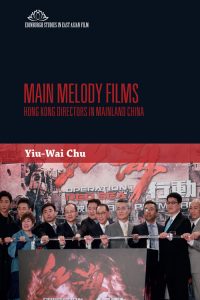 Main Melody Films: Hong Kong Directors in Mainland China
Main Melody Films: Hong Kong Directors in Mainland China
Year: 2022
Author: Stephen Yiu-Wai Chu
- Provides an in-depth study of Hong Kong directors’ participation in Chinese ‘main-melody’ blockbusters in the 2010s
- Sheds light on the development of cross-border cooperation of Mainland and Hong Kong film industries, and general film studies regarding cross-cultural collaborations
- Explores the move from Mainland-Hong Kong dichotomy, shifting the emphasis to cultural translations across the border
- Helps researchers understand changing values in a new era of Chinese film production
- Main melody films are propaganda works that pay tribute to the Chinese nation, the party and the army. Since the turn of the century, they have gradually developed into the main genre of Chinese cinema, and its “blockbusterization” is arguably the most phenomenal aspect of the 2010s Chinese film industry.
Contents:
Introduction: “Main(land) Melody Films” and Hong Kong Directors
1: How to Take Tiger Mountain? The Tsui Hark Model
2: Will Our Time Come? Ann Hui’s Fallen City
3: Hong Kong Dreams in China: The Leap of Peter Chan
4: Founding an Army with Soft Power: Captain Andrew Lau
5: Stepping to the Fore: Dante Lam’s Operation Trilogy
6: Underneath the Shock Waves: The (Un)told Stories of Herman Yau
7: Jumping on the Bandwagon: The Ensemble of Hong Kong Film Directors
Epilogue
Select Bibliography
Filmography
Glossary
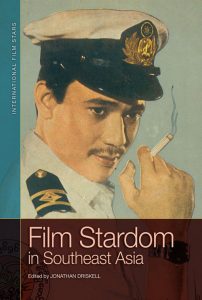 Film Stardom in South East Asia
Film Stardom in South East Asia
Year: 2022
Editor: Jonathan Driskell
- Analyses the cinematic and social significance of the star phenomenon in Southeast Asia
- The first book to address the important role played by film stars in Southeast Asian cinema
- Provides detailed case studies of many of the region’s biggest stars, including Bea Alonso, Nora Aunor, Kiều Chinh, John Lloyd Cruz, Sharon Cuneta, Ananda Everingham, Rhoma Irama, P. Ramlee, and Jeeja Yanin
- Re-examines the region’s cinema from the perspective of stardom, offering fresh insight into its rich popular filmmaking traditions
- Offers new perspectives on key historical and political contexts through case studies focusing on stars from across the region and from the 1950s to the present day
- Brings together experts in the cinemas of Burma, Cambodia, Indonesia, Malaysia/ Singapore, the Philippines, Thailand and Vietnam to provide a comprehensive regional perspective on the star phenomenon
Contents:
Introduction (Jonathan Driskell)
Spectral Stars, Haunted Screens: Cambodian Golden Age Cinema (Annette Hamilton)
P. Ramlee, the Star: Malay Stardom and Society in the 1950s-1960s (Jonathan Driskell)
Shake it Like Elvis: Win Oo, the Culturally Appropriate Heart Throb of the Burmese Socialist Years (Jane M. Ferguson)
Trà Giang’s Stardom in Wartime Vietnam: Simple Glamour, Socialist Modernity, and Acting Agency (Qui-Ha Hoang Nguyen)
Seeking a Passport: The Transnational Career of Kiều Chinh – Pujita Guha
Three Kinds of Stardom in Indonesia (David Hanan)
The Indonesian Sex Bomb: Female Sexuality in Cinema 1970s-1990s (Thomas Barker)
Nora Aunor and Sharon Cuneta as Migrant Workers: Stars and Labour Export in Filipino Commercial Films (Katrina Ross Tan)
One More Second Chance: Love Team Longevity and Utility in the Era of the Television Studio (Chrishandra Sebastiampillai)
The Changing Status of the Thai Luk Khrueng (Eurasian) Performer: A Case Study of Ananda Everingham (Mary J. Ainslie)
Fight like a Girl: Jeeja Yanin as a Female Martial Arts Star (Katarzyna Ancuta)
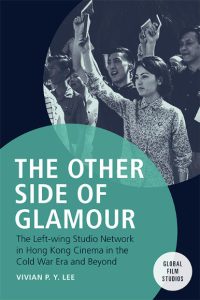 The Other Side of Glamour: The Left-wing Studio Network in Hong Kong Cinema in the Cold War Era and Beyond
The Other Side of Glamour: The Left-wing Studio Network in Hong Kong Cinema in the Cold War Era and Beyond
Year: 2022
Author: Vivian P.Y. Lee
- Studies the historical origins and transformation in styles and production modes of Hong Kong’s left-wing studios
- What does it mean to be on the “left” of the Hong Kong film industry during the Cold War era?
- How did the left-wing studios balance their artistic, ideological, and commercial agendas in their production and exhibition strategies?
- What makes a film “left-wing” or “right-wing”?
- How did national, colonial, and international politics intervene in the ‘making of’ the popular left-wing cinema in Hong Kong?
- How did the left-wing film establishment in Hong Kong reinvent itself in the post-Cold War, post-Cultural Revolution era?
- What are the nuanced legacies of the classical left-wing in Hong Kong cinema today?
Contents:
Acknowledgements
List of Figures
Timeline
Introduction
Chapter 1 The Left-wing Film Network in Post-war Hong Kong
Chapter 2 Left in the Right Way: Corporate Strategy and the Making of a Popular Left-wing
Chapter 3 Remaking Cantonese Film Culture: Union and Sun Luen
Chapter 4 Class, Gender, and Modern Womanhood: Feng Huang and Great Wall
Chapter 5 Corporate Repositioning, Transnational Cultural Brokerage and Soft Power: Sil-Metropole
Chapter 6 Critical Transitions on the Non-left: Patrick Lung and Cecile Tang
Chapter 7 From Political Alibis to Creative Incubators: the Left-wing Film Network since the 1980s
Epilogue
Endnotes
Bibliography
 Sino-Enchantment: The Fantastic in Contemporary Chinese Cinemas
Sino-Enchantment: The Fantastic in Contemporary Chinese Cinemas
Year: 2021
Editors: Kenneth Chan and Andrew Stuckey
- Approaches the recent resurgence of the fantastic in Chinese cinemas
- Offers the framework of ‘Sino-enchantment’ as a new theoretical lens through which readers can engage elements of the fantastic in Chinese cinema.
- Addresses the increasing prominence of fantastic narratives, imagery and styles in Chinese films
- Interested not simply in CGI effects, but as much in the ideological, aesthetic and ethical ramifications of the fantastic in contemporary film culture
Contents:
Introduction: The Fantastic as Sino-Enchantment in Contemporary Chinese Cinemas (Kenneth Chan and Andrew Stuckey)
Visuality/Virtuality
1. Heroic Human Pixels: Mass Ornaments and Digital Multitudes in Zhang Yimou’s Spectacles (Jason McGrath)
2. The Spectacle of Co-Production in The Great Wall (Dan North)
3. The Blockbuster Breakthrough: The Fantastic in Hero (Li Yang)
Genres of Sino-Enchantment
4. The Restrained Fantastic in Hou Hsiao-hsien’s The Assassin (Andrew Stuckey)
5. An Auteurist Journey through the Fantastic Mode: A Case Study of Ho Meng-hua (Shi-Yan Chao)
6. Tracing the Science Fiction Genre in Hong Kong Cinema, Tom Cunliffe
7. Chick Flick Fantasy and Postfeminism in Chinese Cinema: 20 Once Again as a Transnational Remake (Elaine Chung)
8. The Sacred Spectacle: Subverting Skepticism in Tsui Hark’s Detective Dee Films (Ian Pettigrew)
Ethics
9. Almost Wild, But Not Quite: The Indexical and the Fantastic Animal Other in China-Coproduced (Eco)Cinema (Yiman Wang)
10. Domesticity, Sentimentality and Otherness: The Boundary of the Human in Monster Hunt (Mei Yang)
11. Transforming Tripitaka: Toward a (Buddhist) Planetary Ethics in Stephen Chow’s Adaptation of Journey to the West (Kenneth Chan)
Coda: Sino-Enchantment in a Time of Crisis (Kenneth Chan and Andrew Stuckey)
Selected Filmography
Bibliography
year: 2021
Author: Olivia Khoo
- Studies the dynamic industrial and cultural transformations that have produced a regional Asian cinema in the last three decades
- Includes case studies that illustrate collaborative models of film production, distribution, exhibition and reception that have shaped a regional Asian cinema in the last three decades
- Offers a new framework that synthesises Euro-American film studies approaches and inter-Asia cultural studies methodologies
- Contributes to the burgeoning international fields of transnational and world cinema, providing a fresh perspective on Asian cinema through the lens of comparative film studies
Contents:
Acknowledgements
List of Figures
- Introduction: Theorising Asian Cinema as a Regional Cinema
- Pan-Asian Filmmaking and Co-Productions with China: Horizontal Collaborations and Vertical Aspirations
- Re-making Asian Cinema: Inter-Asian Remakes and Asian Omnibus Films
- From Film Festivals to Online Streaming: Circuits of Distribution and Exhibition
- Queer Asian Cinema and the Short Film Format: Rethinking Female Authorship
- Archiving Asian Cinema
- Asian Cinema in 3D: Regional Technical Innovation
Epilogue: New Regional Intimacies
Notes
Bibliography
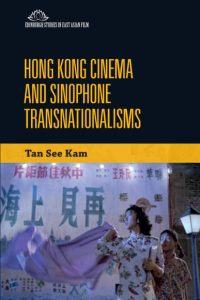 Hong Kong Cinema and Sinophone Transnationalisms
Hong Kong Cinema and Sinophone Transnationalisms
Year: 2021
Author: See Kam Tan
Hong Kong Cinema and Sinophone Transnationalisms explores the intricate complexity of selected films and film-making practices from 1930s Hong Kong (and Shanghai) to the later ‘new wave’ phenomenon of the 1980s. The result is a Sinophone cinema that created some very different ways of understanding ‘China’ and ‘Chineseness’, developing their own ‘cosmopolitan dreaming’ within the cultural and economic changes of those times. Exploring sinification and its multiple manifestations in film, the book examines cinematic genres including Huangmei Opera films, qiqing (strange or queer romance) films, fanchuaners (professional cross-sex performers) in film, Hong Kong’s Bond Movies (bangpian), erotic (fengyue) films, and New Wave Hong Kong cinema. In doing so, this book lays fruitful foundations for further understanding the development and changing faces of Hong Kong films and sinophone transnationalism in the even more complex and changing times of today.
Contents:
Acknowledgements
A Note on Language
Glossary I: Chinese-language Film Titles
Glossary II: Chinese-language Names (Persons, Film Companies, etc.)
Glossary III: Chinese-language Terms and Phrases
Illustrations
Preface
I NEW BEGINNINGS
Chapter One: Locating Sinophone Cinema
Chapter Two: The Sinification of Early Shanghai and Hong Kong Cinema
II NEW DIRECTIONS
Chapter Three: Huangmei diao pian
Chapter Four – Caizi/Jiaren Romance in Disguise
Chapter Five: Fanchuan Acting: Cross-dressing and Performative Transexualities
III NEW IMAGINARIES
Chapter Six: Tongzhi Articulations in Fengyue Films
Chapter Seven: Transness: Hong Kong’s Bond Movies (Bangpian)
IV NEW WAVES
Chapter Eight: Tsui Hark: Accented Cinema
Chapter Nine: Tsui Hark: Time-Bomb Cinema
Chapter Ten: Tsui Hark: New Localisms
Afterword
Appendix: A Selection of Chinese-language Opera Film Avatars
Filmography and TV Resources
References
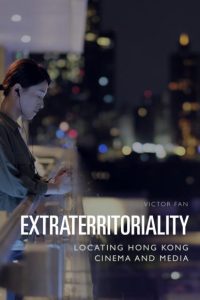 Extraterritoriality: Locating Hong Kong Cinema and Media
Extraterritoriality: Locating Hong Kong Cinema and Media
Year: 2021
Author: Victor Fan
- Actively rewrites and reconfigures how Hong Kong cinema and media are to be defined and located
Examining how Hong Kong filmmakers, spectators and critics wrestled with this perturbation between the Leftist Riots (1967) and the aftermath of the Umbrella Movement (2014), this book traces how Hong Kong’s extraterritoriality has been framed: in its position of being doubly occupied and doubly abandoned by contesting juridical, political, linguistic and cultural forces. Extraterritoriality scrutinises creative works in mainstream cinema, independent films, television, video artworks and documentaries – especially those by marginalised artists – actively rewriting and reconfiguring how Hong Kong cinema and media are to be defined and located.
Contents:
Acknowledgements
Notes on Transliteration
On Extraterritoriality
Chapter 1: What is Hong Kong Cinema?
Chapter 2: Breaking the Wave
Chapter 3: The Time It Takes for Time to End
Chapter 4: Posthistoricity
Chapter 5: The Age of Precarity
The Body of Extraterritoriality
Notes
Filmography and Videography
Index
 Killers, Clients and Kindred Spirits: The Taboo Cinema of Shohei Imamura
Killers, Clients and Kindred Spirits: The Taboo Cinema of Shohei Imamura
Year: 2021
Editors: Lindsay Coleman and David Desser
- A thorough exploration of the work of one of Japan’s most controversial directors
The only Japanese director to have won the Palme d’Or from Cannes more than once, and second only to Ozu Yasujiro in the number of times he has won the prestigious Kinema Jumpo Best One award, the late Imamura Shohei was one of Japan’s leading and most controversial film directors. This book is one of the first to study all of Imamura’s major films alongside his television and theatrical documentaries, focusing on his major themes and concerns. By giving shape to Imamura’s career, the book positions him as a stylistic innovator as well as an ethnographic investigator into Japanese culture and tradition; the preeminent examiner of the hidden, barely repressed underpinnings of Japanese society.
Contents:
Chapter 1: Introduction
Chapter 2: The Making of An Auteur: The Early Films (1958-1959) (Jennifer Coates)
Section I: Killers
Chapter 3: Confronting America: Pigs and Battleships and the Politics of US Bases in Postwar Japan (Hiroshi Kitamura)
Chapter 4: Insect Men and Women: Gender, Conflict and Problematic Modernity in Intentions of Murder (Adam Bingham)
Chapter 5: Hidden in Plain Sight: The False Leads and True Mysteries of Vengeance Is Mine (John Berra)
Chapter 6: The Eel: Trauma Cinema (David Desser)
Section II: Clients
Chapter 7: The Insect Woman, or: The Female Art of Failure (Michael Raine)
Chapter 8: The Obscene in the Everyday: The Pornographers (Lindsay Coleman)
Chapter 9: Shōhei Imamura’s Profound Desire for Japan’s Cultural Roots: Critical Approaches to Profound Desires of the Gods (Mats Karlsson)
Chapter 10: ‘Products of Japan’: Karayuki-san, The Making of a Prostitute (Joan Mellen)
Chapter 11: The Female Body as Transgressor of National Boundaries: The History of Postwar Japan as Told by a Bar Hostess (Bianca Briciu)
Part III: Kindred Spirits
Chapter 12: Better off Being Bacteria: Adaptation and Allegory in Dr Akagi (Lauri Kitsnik)
Chapter 13: Time out of Joint: Shōhei Imamura and the Search for an ‘Other’ Japan (Bill Mihalopoulos)
Chapter 14: Promotional Discourses and the Meanings of The Ballad of Narayama (Rayna Denison)
Chapter 15: Boundary Play: Truth, Fiction, and Performance in A Man Vanishes (Diane Lewis)
Chapter 16: Why Not? – Imamura, Nietzsche and the Untimely (David Deamer)
Chapter 17: Kuroi ame: An Anthropology of Suffering (Dolores Martinez)
Chapter 18: The Symbolic Function of Water (Tim Iles)
Notes on Contributors
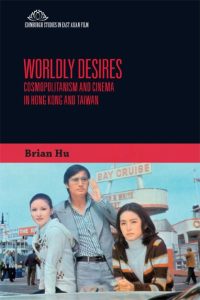 Worldly Desires: Cosmopolitanism and Cinema in Hong Kong and Taiwan
Worldly Desires: Cosmopolitanism and Cinema in Hong Kong and Taiwan
Year: 2020
Author: Brian Hu
Examines the role that cinema played in imagining Hong Kong and Taiwan’s place in the world
How does cinema imagine our place in the world? This book looks at the studios, films and policies that charted the transnational vision of Hong Kong and Taiwan, two places with an uneasy relationship to the idea of nationhood. Examining the cultural, political and industrial overlaps between these cinemas – as well as the areas where they uniquely parallel each other – author Brian Hu brings together perspectives from cinema studies, Chinese studies and Asian American studies to show how culture is produced in the spaces between empires. With case studies of popular stars like Linda Lin Dai and Edison Chen, and spectacular genres like the Shaolin Temple cycle of martial arts films and the romantic melodramas of 1970s Taiwan, this book explores what it meant to be both cosmopolitan and Chinese in the second half of the twentieth century.
Contents:
Acknowledgements
Introduction
Chapter 1: Melodramas of Arrival and Departure: jet-set students in 1970s Taiwanese romance
Chapter 2: ABCs, Mixed-race Stars, and other Monsters of Globalization
Chapter 3: Setting the Stage: Hong Kong musical stars take on the world
Chapter 4: All the Right Moves: mobile heroes and the Shaolin Temple film
Chapter 5: The Cosmopolitan Brand: film policy as cultural work in the international film market
Chapter 6: Conclusion
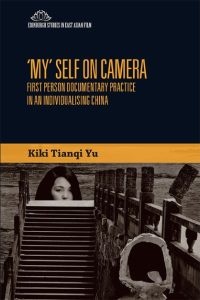 ‘My’ Self on Camera: First Person Documentary Practice in an Individualising China
‘My’ Self on Camera: First Person Documentary Practice in an Individualising China
Year: 2020
Author: Kiki Tianqi Yu
- An exploration of first person narrative documentary in China’s post-Mao era
‘My’ Self on Camera is the first book to explore first person narrative documentary in China’s post-Mao era. Since the emergence of the individual as an ever more important social figure in China, this mode of independent filmmaking and cultural practice has become increasingly significant. Combining the approach of cultural ethnography, interviews, and textual analysis of selected films, this study examines the motivations, key aesthetic features and ethical tensions of presenting the self on camera, as well as the socio-political, cultural and technical conditions surrounding its practice. This book problematises how the sense of self and subjectivities are understood in contemporary China, and provides illuminating new insights on the changing notion of the individual through cinema.
Contents:
List of Figures
List of Main Terms with Chinese Translations
List of Names with Chinese Character Translations
Acknowledgements
Introduction: Action, Amateurness and the Changing Sense of the Individual Self
1. Female First Person Documentary Practice: Negotiating Gendered Expectations
2. Amateurness and an Inward Gaze at Home
3. Nostalgia toward Laojia: Old Home as an Imagined Past
4. First Person Action Documentary Practice: Longing for a More Politicised Space
5. The Problematic Public Self: Ethics, Camera and Language in Contestable Minjian Public Spaces
6. Camera Activism: Provocative Documentation, First Person Confrontation and Collective Force
7. Whose Self on Camera? Motives, Mistrust, Disputed Authenticities
8. From Fragile First Person Documentary Practice to Popular Online First Person Live Streaming Broadcast – Zhibo: Changing Intentions, Changing Individual Selves
Filmography
Bibliography
Index
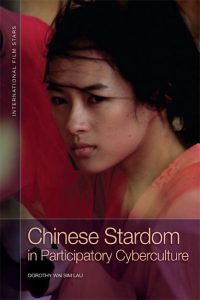 Chinese Stardom in Participatory Cyberculture
Chinese Stardom in Participatory Cyberculture
Year: 2020
Author: Dorothy Wai Sim Lau
- Examines transnational Chinese stardom as a Web-based phenomenon
- Generates a new model to address the virtual forms of stardom and the under-explored dimensions of Chinese stars
- Revisits the star construction of globally acclaimed Chinese performers such as Jet Li, Jackie Chan and Donnie Yen
- Themes include: star performance; the star body; ethnicity; stars and audience; and phonic persona
Contents:
Acknowledgements
List of Figures
Note on the Text
Introduction: A Phenomenon After Cinema – The Chinese Stardom Goes ‘Cyber’
Chapter 1 – Blogging Donnie Yen: Remaking the Martial Arts Body as a Cyber-Intertext
Chapter 2 – ‘Flickering’ Jackie Chan: The Actor-Ambassadorial Persona on Photo-sharing Sites
Chapter 3 – ‘Friending’ Jet Li on Facebook: The Celebrity-Philanthropist Persona in Online Social Networks
Chapter 4 – YouTubing Zhang Ziyi: Chinese Female Stardom in Fan Videos on Video-sharing Sites
Chapter 5 – Discussing Takeshi Kaneshiro: The Pan-Asian Star Image on Fan Forums
Conclusion – Reimagining Chineseness in the Global Cyber Culture
Filmography
Bibliography
Index
Film-Philosophy is dedicated to the engagement between film studies and philosophy, exploring the ways in which films develop and contribute to philosophical discussion. The journal also provides a forum for the thoughtful re-evaluation of key aspects of both film studies and philosophy as academic disciplines.
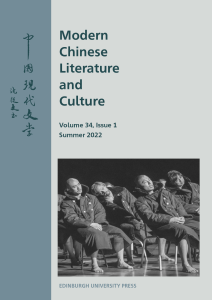 Modern Chinese Literature and Culture (Journal)
Modern Chinese Literature and Culture (Journal)
New for 2022
This is a biannual journal featuring critical research on Chinese literature and culture, from the avant-garde to the popular, encompassing film, drama, art, performance, media history, print culture, and more. Started in 1975, the journal has become essential in its field and is today a key publication in Chinese studies.
